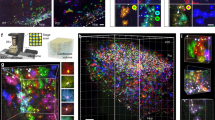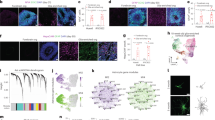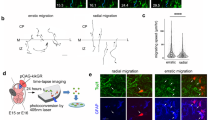Abstract
Glial cells constitute nearly 50% of the cells in the human brain1. Astrocytes, which make up the largest glial population, are crucial to the regulation of synaptic connectivity during postnatal development2. Because defects in astrocyte generation are associated with severe neurological disorders such as brain tumours3, it is important to understand how astrocytes are produced. Astrocytes reportedly arise from two sources4,5,6: radial glia in the ventricular zone and progenitors in the subventricular zone, with the contribution from each region shifting with time. During the first three weeks of postnatal development, the glial cell population, which contains predominantly astrocytes, expands 6–8-fold in the rodent brain7. Little is known about the mechanisms underlying this expansion. Here we show that a major source of glia in the postnatal cortex in mice is the local proliferation of differentiated astrocytes. Unlike glial progenitors in the subventricular zone, differentiated astrocytes undergo symmetric division, and their progeny integrate functionally into the existing glial network as mature astrocytes that form endfeet with blood vessels, couple electrically to neighbouring astrocytes, and take up glutamate after neuronal activity.
This is a preview of subscription content, access via your institution
Access options
Subscribe to this journal
Receive 51 print issues and online access
$199.00 per year
only $3.90 per issue
Buy this article
- Purchase on Springer Link
- Instant access to full article PDF
Prices may be subject to local taxes which are calculated during checkout




Similar content being viewed by others
References
Azevedo, F. A. et al. Equal numbers of neuronal and nonneuronal cells make the human brain an isometrically scaled-up primate brain. J. Comp. Neurol. 513, 532–541 (2009)
Eroglu, C. & Barres, B. A. Regulation of synaptic connectivity by glia. Nature 468, 223–231 (2010)
Schwartzbaum, J. A., Fisher, J. L., Aldape, K. D. & Wrensch, M. Epidemiology and molecular pathology of glioma. Nat. Clin. Pract. Neurol. 2, 494–503 (2006)
Cameron, R. S. & Rakic, P. Glial cell lineage in the cerebral cortex: a review and synthesis. Glia 4, 124–137 (1991)
Marshall, C. A., Suzuki, S. O. & Goldman, J. E. Gliogenic and neurogenic progenitors of the subventricular zone: who are they, where did they come from, and where are they going? Glia 43, 52–61 (2003)
Kriegstein, A. & Alvarez-Buylla, A. The glial nature of embryonic and adult neural stem cells. Annu. Rev. Neurosci. 32, 149–184 (2009)
Bandeira, F., Lent, R. & Herculano-Houzel, S. Changing numbers of neuronal and non-neuronal cells underlie postnatal brain growth in the rat. Proc. Natl Acad. Sci. USA 106, 14108–14113 (2009)
Levison, S. W. & Goldman, J. E. Both oligodendrocytes and astrocytes develop from progenitors in the subventricular zone of postnatal rat forebrain. Neuron 10, 201–212 (1993)
Zerlin, M., Levison, S. W. & Goldman, J. E. Early patterns of migration, morphogenesis, and intermediate filament expression of subventricular zone cells in the postnatal rat forebrain. J. Neurosci. 15, 7238–7249 (1995)
Smart, I. & Leblond, C. P. Evidence for division and transformations of neuroglia cells in the mouse brain, as derived from radioautography after injection of thymidine-H3 . J. Comp. Neurol. 116, 349–367 (1961)
Suh, H. et al. In vivo fate analysis reveals the multipotent and self-renewal capacities of Sox2+ neural stem cells in the adult hippocampus. Cell Stem Cell 1, 515–528 (2007)
Guo, F., Ma, J., McCauley, E., Bannerman, P. & Pleasure, D. Early postnatal proteolipid promoter-expressing progenitors produce multilineage cells in vivo . J. Neurosci. 29, 7256–7270 (2009)
Sakaue-Sawano, A. et al. Visualizing spatiotemporal dynamics of multicellular cell-cycle progression. Cell 132, 487–498 (2008)
Ge, W. P., Zhou, W., Luo, Q., Jan, L. Y. & Jan, Y. N. Dividing glial cells maintain differentiated properties including complex morphology and functional synapses. Proc. Natl Acad. Sci. USA 106, 328–333 (2009)
Ge, W. P. et al. Long-term potentiation of neuron-glia synapses mediated by Ca2+-permeable AMPA receptors. Science 312, 1533–1537 (2006)
Wang, D. D., Krueger, D. D. & Bordey, A. Biophysical properties and ionic signature of neuronal progenitors of the postnatal subventricular zone in situ. J. Neurophysiol. 90, 2291–2302 (2003)
Madisen, L. et al. A robust and high-throughput Cre reporting and characterization system for the whole mouse brain. Nature Neurosci. 13, 133–140 (2010)
Casper, K. B., Jones, K. & McCarthy, K. D. Characterization of astrocyte-specific conditional knockouts. Genesis 45, 292–299 (2007)
Zhuo, L. et al. Live astrocytes visualized by green fluorescent protein in transgenic mice. Dev. Biol. 187, 36–42 (1997)
Burns, K. A., Murphy, B., Danzer, S. C. & Kuan, C. Y. Developmental and post-injury cortical gliogenesis: a genetic fate-mapping study with Nestin-CreER mice. Glia 57, 1115–1129 (2009)
Zhu, X. et al. Age-dependent fate and lineage restriction of single NG2 cells. Development 138, 745–753 (2011)
Matthias, K. et al. Segregated expression of AMPA-type glutamate receptors and glutamate transporters defines distinct astrocyte populations in the mouse hippocampus. J. Neurosci. 23, 1750–1758 (2003)
Buffo, A. et al. Origin and progeny of reactive gliosis: a source of multipotent cells in the injured brain. Proc. Natl Acad. Sci. USA 105, 3581–3586 (2008)
Xu, H. T., Pan, F., Yang, G. & Gan, W. B. Choice of cranial window type for in vivo imaging affects dendritic spine turnover in the cortex. Nature Neurosci. 10, 549–551 (2007)
Doetsch, F., Caille, I., Lim, D. A., Garcia-Verdugo, J. M. & Alvarez-Buylla, A. Subventricular zone astrocytes are neural stem cells in the adult mammalian brain. Cell 97, 703–716 (1999)
Gutnick, M. J., Connors, B. W. & Ransom, B. R. Dye-coupling between glial cells in the guinea pig neocortical slice. Brain Res. 213, 486–492 (1981)
Bergles, D. E. & Jahr, C. E. Synaptic activation of glutamate transporters in hippocampal astrocytes. Neuron 19, 1297–1308 (1997)
Ge, W. P. & Duan, S. Persistent enhancement of neuron-glia signaling mediated by increased extracellular K+ accompanying long-term synaptic potentiation. J. Neurophysiol. 97, 2564–2569 (2007)
Takano, T. et al. Astrocyte-mediated control of cerebral blood flow. Nature Neurosci. 9, 260–267 (2006)
Rouach, N., Koulakoff, A., Abudara, V., Willecke, K. & Giaume, C. Astroglial metabolic networks sustain hippocampal synaptic transmission. Science 322, 1551–1555 (2008)
Zhu, X., Bergles, D. E. & Nishiyama, A. NG2 cells generate both oligodendrocytes and gray matter astrocytes. Development 135, 145–157 (2008)
Li, G. et al. Regional distribution of cortical interneurons and development of inhibitory tone are regulated by Cxcl12/Cxcr4 signaling. J. Neurosci. 28, 1085–1098 (2008)
Tashiro, A., Zhao, C. & Gage, F. H. Retrovirus-mediated single-cell gene knockout technique in adult newborn neurons in vivo . Nature Protocols 1, 3049–3055 (2006)
Merkle, F. T., Mirzadeh, Z. & Alvarez-Buylla, A. Mosaic organization of neural stem cells in the adult brain. Science 317, 381–384 (2007)
Barres, B. A. et al. Cell death and control of cell survival in the oligodendrocyte lineage. Cell 70, 31–46 (1992)
Krueger, B. K., Burne, J. F. & Raff, M. C. Evidence for large-scale astrocyte death in the developing cerebellum. J. Neurosci. 15, 3366–3374 (1995)
Acknowledgements
We thank K. D. McCarthy and H. Zeng for providing us with the hGFAP-CreER and Ai14 transgenic mice, respectively; A. Sakaue-Sawano for the CAG-Fucci-Green transgenic mice; M. Stryker, Y. Xiang, X.-q. Wang, S. Barbel, J.-d. Chen, W. Zhou, F. Huang, and members of the Jan laboratory for discussion; G.-n. Li for help on electroporation; Y. Li for advice on retroviral experiments; and E. Unger, C Guo, H. Yang, Q. Deng, J. Berg and X-y. Li for reading the manuscript. W.-P.G. is a recipient of a Long-Term Fellowship of Human Frontier Science Program (HFSP) and National Institute of Neurological Disorders and Stroke (NINDS) Pathway to Independence Award. This work was supported by a NINDS K99/R00 award (1K99NS073735) to W.-P.G., a National Institute of Mental Health R37 grant (4R37MH065334) to L.Y.J, a National Institutes of Health (NIH) R01 grant (5R01MH084234) to Y.N.J., and grants from the NIH/National Institute on Aging P01 AG010435, MH090258, Jeffry M. and Barbara Picower Foundation (JBP) and McDonnell Foundation to F.H.G. L.Y.J. and Y.N.J. are Howard Hughes Medical Institute investigators.
Author information
Authors and Affiliations
Contributions
W.-P.G. conceived the project, designed and performed the experiments and analysed the data. L.Y.J. and Y.N.J. supervised the work and helped to design the experiments. W.-P.G. and L.Y.J. wrote the manuscript. F.H.G. and A.M. provided MLV retrovirus and CAG-Fucci-Green transgenic mice, respectively. All authors reviewed and edited the manuscript.
Corresponding author
Ethics declarations
Competing interests
The authors declare no competing financial interests.
Supplementary information
Supplementary Information
This file contains Supplementary Figures 1-14 and Supplementary Table 1. (PDF 11538 kb)
Supplementary Movie 1
A movie showing local division of astrocytes in a cortical slice (cortical layers I-IV) from a P3 hGFAP-GFP tg mouse. Total time of the movie is 2 hr 46 min. (MOV 2430 kb)
Rights and permissions
About this article
Cite this article
Ge, WP., Miyawaki, A., Gage, F. et al. Local generation of glia is a major astrocyte source in postnatal cortex. Nature 484, 376–380 (2012). https://doi.org/10.1038/nature10959
Received:
Accepted:
Published:
Issue Date:
DOI: https://doi.org/10.1038/nature10959
This article is cited by
-
Distinct forebrain regions define a dichotomous astrocytic profile in multiple system atrophy
Acta Neuropathologica Communications (2024)
-
Astrocytes in the adult dentate gyrus—balance between adult and developmental tasks
Molecular Psychiatry (2024)
-
Astroglial Hmgb1 regulates postnatal astrocyte morphogenesis and cerebrovascular maturation
Nature Communications (2023)
-
Lipocalin-2: a therapeutic target to overcome neurodegenerative diseases by regulating reactive astrogliosis
Experimental & Molecular Medicine (2023)
-
The Structure and Function of Glial Networks: Beyond the Neuronal Connections
Neuroscience Bulletin (2023)
Comments
By submitting a comment you agree to abide by our Terms and Community Guidelines. If you find something abusive or that does not comply with our terms or guidelines please flag it as inappropriate.



